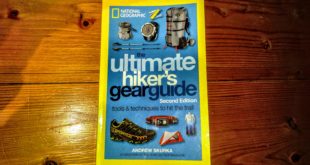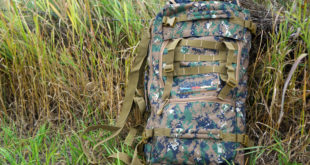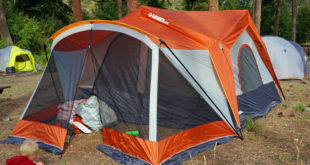Seeing as this is a book review… it seems that a written report is in order
Over the last few years of backpacking, I have come to feel that I carry way to much ‘stuff’ in my pack. Granted, I have made a lot of improvements over the past few years, shedding a lot of unnecessary clothing and keeping my “extra” food to a reasonable level. Still, in spite of that, I struggle to come out with a packed weight less than 45 lbs… and I can now say from experience that after 10 miles and a few thousand feet of elevation gain, that I am still carrying too much weight.
For this reason I leapt at an opportunity to read the “Ultimate Hiker’s Gear Guide” by Andrew Skurka. I figured can only benefit from the experience of someone who has several thousand more miles on the trail than me, and this assumption proves generally correct in the case of this book of “tools and techniques to hit the trail”
The book is divided into three sections. The first 19 pages focuses on the definition of a hiker and outlines the necessary knowledge and mental preparation required to be able to get the most out of hiking.
The next 162 pages focus on gear. This section provides a very comprehensive look at every major piece of hiking gear, providing a comparison of the different options available and occasionally a critical look at popular gear that’s available (for example, double wall backpacking tents and waterproof-breathable fabrics).
The final part of 22 pages lists out example hiking scenarios and give an idea of what you would find in Andrew Skurka’s pack when planning a hike in the Appalacians, Arctic or even a desert.
In spite of the fact that the first section is a mere 19 pages, I found it to be an extremely valuable read. The importance and value of proper preparation cannot be underestimated, and it is useful to see some of the sources that I can rely on to get reasonable information. Beyond that though is what a hiker (or ultimate hiker) values in the outdoor experience. The constant forward progress that is made from first thing in the morning to the end of the day is very valuable, going at a pace that enables the hiker to appreciate the outdoor surroundings while knowing that at the end of the day a lot of ground will have been covered (more than a normal hiker would) and that there is opportunity to explore much more remote wilderness than might be otherwise available. To reach this an ultimate hiker is mentally prepared to rarely be 100% comfortable, but sufficiently geared and prepared to safely enjoy the best the outdoors has to offer.
The gear section is something of a mixed bag, but ultimately full of valuable gems of knowledge. Andrew provides a very detailed and comprehensive view of every major piece of gear, providing useful comparisons of the strengths and weaknesses of different pieces of gear (think “Down vs. Synthetic” sleeping bags, “Double-wall vs Single-wall vs Tarp” tents and “Wood vs. Canister vs. Alcohol” stoves). At the end of the day he makes a few judgement calls, but what you generally find is that there is little gear that Andrew will ‘never’ use, but rather that it depends on the conditions of usefulness.
A few sections that I found particularly interesting and worthwhile was the sections on Food, Shelter, and Footwear. After reading the food section I decided to follow a bit of Andrew’s reasoning and packed a lot of chips and chocolate to the Washington Enchantments in order to have a higher fat diet for more energy. Overall I found myself sufficiently filled though I found my chips crumbled a lot and would not easily pack down.
The last section of sample gear lists I found to be useful, though I only glanced through it. It is something to be aware of as there, but I realistically wouldn’t read it unless I was planning a hike that conformed to some of the conditions outlined. What I found of considerably more value was HOW this lists are organized. Lists are very valuable and its useful to see how someone else organizes theirs to see how I might improve mine.
Along with several anecdotal stories sprinkled throughout the book, I found the Ultimate Hiker’s guide to be a nice read. I would consider Part 1 a section worth deliberate straight through reading, as it contains valuable information even if it is review or even ‘common sense.’ Having the planning and hiking techniques written on paper makes me think about it more, and in many ways I wish this section was a bigger. The gear section is great for random reading, where you want to take a few minutes break and consider your gear. Being away of the breadth of material covered is helpful so that whenever you ask yourself “what sort of material might be best for the rain” you can find the section at the time it interests you most. While the specific gear recommendations will become dated with time, it does give an idea of relative cost to get particular pieces of gear. At its extreme, if you want to look like Andrew Skurka (if only in gear) that option is available to you, but overall, this book enables you to make very educated decisions about the gear you need to meet the conditions you may face along with a few bit of advice on where its beneficial to spend more money (think footwear) vs when going on the cheap is perfectly workable (think alcohol stoves).
The final word:
I found this book to be a great read with a little bit for everyone. The first section, while short, is by far the most valuable overall. The gear section can sometimes be a bit over-technical (part of the ‘bit for everyone’) but provides a ton of useful charts that I will refer back to for a long time to come. The final gear lists are useful, but much more useful as a guide to record and weigh your own gear.
 The Outdoor Adventure Giving you tips, tricks & recommendations to help make adventuring in the Outdoors fun, safe & exciting for you and your kids.
The Outdoor Adventure Giving you tips, tricks & recommendations to help make adventuring in the Outdoors fun, safe & exciting for you and your kids.





